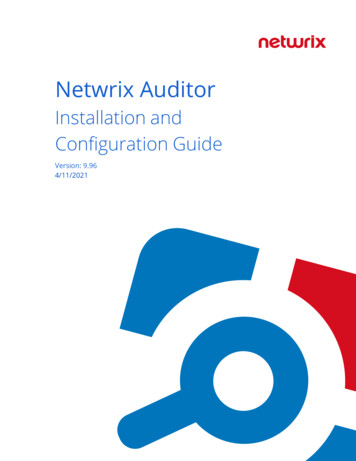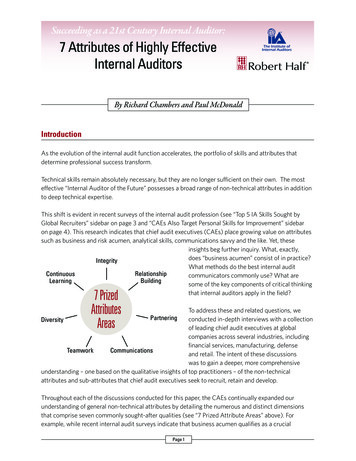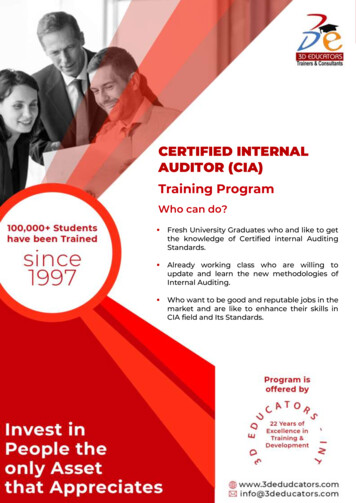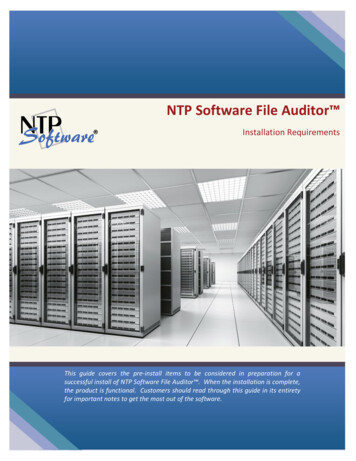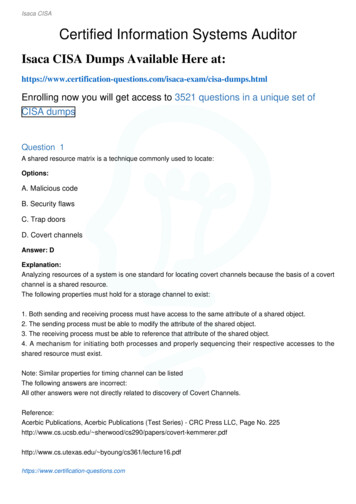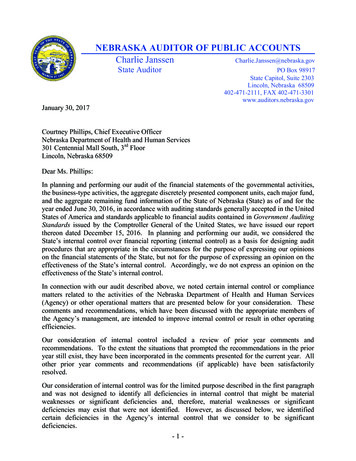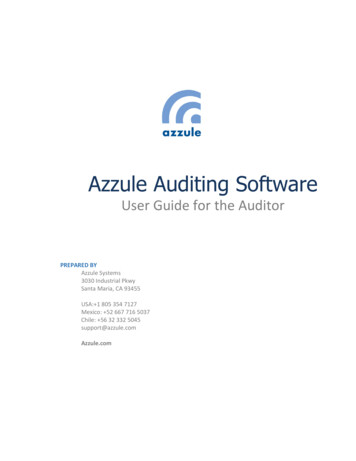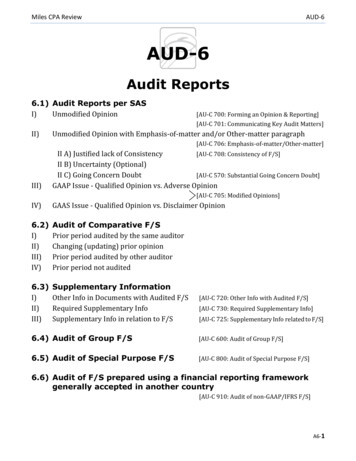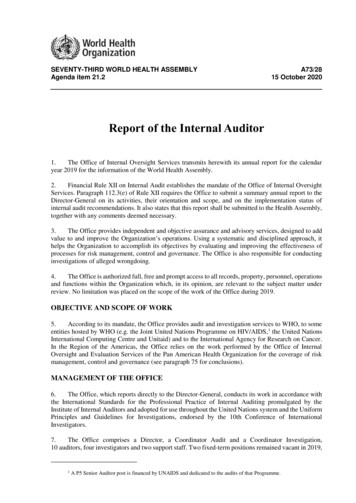
Transcription
SEVENTY-THIRD WORLD HEALTH ASSEMBLYAgenda item 21.2A73/2815 October 2020Report of the Internal Auditor1.The Office of Internal Oversight Services transmits herewith its annual report for the calendaryear 2019 for the information of the World Health Assembly.2.Financial Rule XII on Internal Audit establishes the mandate of the Office of Internal OversightServices. Paragraph 112.3(e) of Rule XII requires the Office to submit a summary annual report to theDirector-General on its activities, their orientation and scope, and on the implementation status ofinternal audit recommendations. It also states that this report shall be submitted to the Health Assembly,together with any comments deemed necessary.3.The Office provides independent and objective assurance and advisory services, designed to addvalue to and improve the Organization’s operations. Using a systematic and disciplined approach, ithelps the Organization to accomplish its objectives by evaluating and improving the effectiveness ofprocesses for risk management, control and governance. The Office is also responsible for conductinginvestigations of alleged wrongdoing.4.The Office is authorized full, free and prompt access to all records, property, personnel, operationsand functions within the Organization which, in its opinion, are relevant to the subject matter underreview. No limitation was placed on the scope of the work of the Office during 2019.OBJECTIVE AND SCOPE OF WORK5.According to its mandate, the Office provides audit and investigation services to WHO, to someentities hosted by WHO (e.g. the Joint United Nations Programme on HIV/AIDS, 1 the United NationsInternational Computing Centre and Unitaid) and to the International Agency for Research on Cancer.In the Region of the Americas, the Office relies on the work performed by the Office of InternalOversight and Evaluation Services of the Pan American Health Organization for the coverage of riskmanagement, control and governance (see paragraph 75 for conclusions).MANAGEMENT OF THE OFFICE6.The Office, which reports directly to the Director-General, conducts its work in accordance withthe International Standards for the Professional Practice of Internal Auditing promulgated by theInstitute of Internal Auditors and adopted for use throughout the United Nations system and the UniformPrinciples and Guidelines for Investigations, endorsed by the 10th Conference of InternationalInvestigators.7.The Office comprises a Director, a Coordinator Audit and a Coordinator Investigation,10 auditors, four investigators and two support staff. Two fixed-term positions remained vacant in 2019,1A P5 Senior Auditor post is financed by UNAIDS and dedicated to the audits of that Programme.
A73/28namely a post of Senior Auditor and the post of Coordinator Investigation. The latter position has beencovered on an acting basis by a senior auditor with investigation experience. In early 2019, the Officerequested five additional investigator posts to address identified gaps and help to clear the investigationcase backlog. As an interim measure, during 2019 the Office established long-term consultant contractswith three external investigators. In order to validate the request for additional staff positions, seniormanagement, in consultation with the Independent Expert Oversight Advisory Committee, agreed theterms of reference and the Office commissioned an external review to assess the current practices,procedures and structure of the investigation function against “best in class” benchmarks, as well as toconsider the resource implications of implementing the proposed “best in class” structure. Following acompetitive bidding process, a leading consultancy firm was awarded the contract in July and the finalreport on the external review was received in December 2019.8.Based on the assessment of the Office’s existing resources, practices and procedures and thefindings from its relevant benchmarks, the consultancy firm identified that a significant increase inresources was required to achieve “best in class” benchmarks. The additional resources required toimplement the proposed revised structure of the Office’s investigation function are summarized inTable 1 below.Table 1. Proposed new “best in class” structureDescriptionNumber of investigatorsCurrent structureFixed-term investigators (one of whom is a technical forensics resource)Consultants – longer-term external consultantsConsultancy firm – to provide contract investigation services431Total under the current structure8New structureFixed term investigators at headquarters in Geneva Investigators – staff and unit leads Technical/specialist staff – such as digital forensics, research analysisFixed-term investigators with a focus on regional supportConsultants/consultancy firms (to provide flexible support at the global level)Total new structure12 to 1410 to 112 to 33 to 43 to 418 to 229.Following a preliminary briefing with the Director-General, the Office is currently working onestablishing an action plan and transition strategy, with options for implementation of the proposedbest-in-class structure.10. The resources made available to the Office are assigned in accordance with identified priorities;however, high-risk situations can develop unpredictably, which may divert human resources away frominitial priorities. Accordingly, the Office prioritizes planned work and then adjusts the schedule in orderto compensate for any unexpected assignments.11. The budget of the Office is distributed between human resources, travel, consultancies andoperating supplies with a view to fulfilling the mandate of the Office. During 2019, the Office was ableto cover its expenses. The Office monitors expenditure on a constant basis and makes efforts to reducetravel costs through efficiency measures.2
A73/2812. With a view to maximizing internal oversight coverage, the Office (a) continuously refines itsaudit risk assessment model so as to allocate its resources to the highest risk areas; (b) periodicallyreviews and adapts its approaches to integrated, operational and desk audits; (c) uses short-form reportsfor operational compliance audits; (d) uses an audit management software system to manage workpapers electronically and facilitate the follow-up of the implementation of recommendations; and(e) uses agreed criteria for the prioritization of reports of concern received for investigation (the highestpriority is given to the investigation of allegations of sexual exploitation and abuse, sexual harassmentand assault).13. The Office has also adapted its approach to report to stakeholders in line with the five componentsof the model issued by the Committee of Sponsoring Organizations of the Treadway Commission,1which has been adopted by WHO as the basis for its accountability framework. The audit plan of workfor 2019 was based on the Office’s independent risk assessment and the WHO Principal Risks. 2 TheOffice continues to work to achieve greater alignment in the reporting of assurance across the “threelines of defence” from management’s assertions on internal control to internal audit findings.14. The Office maintains regular contact with the Organization’s External Auditor to coordinate auditwork and avoid overlaps in coverage. The Office provides copies of internal audit reports to the ExternalAuditor and the Independent Expert Oversight Advisory Committee and participates in meetings of thatCommittee in order to maintain an open dialogue with its members and implement their guidance andrecommendations on matters under their oversight responsibilities. The Office also maintains regularcontact with other departments of the Organization, such as the Evaluation Office, and continues to workwith the WHO accountability functions to further contribute to the strengthening of the Organization’scorporate values.15. The Office has a functional case management system based on SharePoint technology, whichserves as a repository for investigation case files. The Office also uses a secure web-based platform toprovide remote access to internal audit reports upon request from Member States and other parties, asauthorized by the Director-General. To further enhance transparency, in 2020 the Office will include alist of issued audit reports on the WHO website so that Member States have updated information on theaudit reports issued.16. The Office updated its Charter in 2019, which was reviewed by the Independent Expert OversightAdvisory Committee and senior management and approved by the Director-General. The Charter isavailable on the Office’s intranet page.AUDITS17. In accordance with its mandate, the Office provides independent and objective audit, investigationand advisory services, designed to add value to and improve the Organization’s operations and toenhance the integrity and reputation of the Organization. The Office helps the Organization toaccomplish its objectives by bringing a systematic, disciplined approach to evaluating and improvingthe effectiveness of governance, risk management and control processes in order to provide reasonableassurance that (a) risks are appropriately identified and managed; (b) interaction with the variousgovernance groups within the Secretariat occurs in accordance with all relevant rules; (c) significant1 Defines the main areas as the control environment; risk management; control activities; information andcommunication; and monitoring.2 See WHO Principal Risks at: ccountability/WHO Principal Risks.pdf?ua 1 (accessed 12 February 2020).3
A73/28financial, managerial, programmatic and operating information is accurate, reliable and timely; (d) staffand other personnel act in compliance with WHO regulations, rules, policies, standards and procedures;(e) resources are acquired economically, used efficiently and adequately protected; (f) programmes,plans and objectives are achieved and contribute to sustainable results; and (g) continuous improvementin the Organization’s internal control processes.18. At the conclusion of each assignment, the Office prepares a detailed report and makesrecommendations to management, designed to help manage risk, maintain controls and implementeffective governance within the Secretariat. The crucial issues identified during each assignment havebeen summarized in this report. Annex 1 lists the reports issued by the Office under its 2019 plan ofwork, along with information on the status of implementation of open audits as at 12 February 2020.The Office uses a four-tier rating system for its overall conclusions on audits: (1) Satisfactory;(2) Partially satisfactory, with some improvement required; (3) Partially satisfactory, with majorimprovement required; and (4) Unsatisfactory. Given the challenges associated with emergencyoperations, the Office’s plan of work for 2019 focused on country offices with graded emergencies.Integrated audits19. The objective of integrated audits is to assess the performance of WHO at the country level or ofa department/division at a regional office or headquarters in the achievement of results as stated in therelevant workplans, as well as the operational capacity of the respective departments/country offices tosupport the achievement of results. Integrated audits focus on risks to areas and functions under threecomponents: (1) the organizational setting (strategy, core functions of WHO, control environment, riskmanagement, organizational profile, collaboration, and readiness and support for public healthemergencies); (2) the programmatic and operational process (programme budget development andoperational planning, resource mobilization, workplan management, operational support andeffectiveness of key internal controls in transaction processing); and (3) the achievement of results(information and communication, monitoring and performance assessment, sustainability, andevaluation and organizational learning). These three components are further composed of up to 28 areascovering up to 185 control activities, including specific tests designed to assess the effectiveness of theOrganization’s readiness and response to health emergencies in accordance with the updatedperformance standards of the Emergency Response Framework. In 2019, the Office continued to updatethe audit tests and proposed changes to some audit steps.20. Country Office in South Sudan. The audit concluded that the performance of the Country Officewas partially satisfactory, with major improvements required to address high and moderate levels ofresidual risk. The audit noted several good practices, including effective coordination of the emergencyresponse operations across the three levels of the Organization; operational planning at the federal andstate levels; and programme budget monitoring and performance assessment. At the same time, the auditfound significant weaknesses in internal control which compromised the level of assurance, potentiallyimpacting on the achievement of expected results. The audit identified the following issues with a highlevel of residual risk: (a) a country cooperation strategy that was not aligned with the national healthpolicy and strategic plan, the Sustainable Development Goals and key global and regional healthframeworks; (b) inadequate coordination among health sector development partners; (c) a suboptimalhuman resources plan for priority programmes and delays in the implementation of that plan attributedto limited and unsuccessful resource mobilization efforts; (d) poorly managed grants and delays in donorreporting; (e) delays in reporting on direct implementation activities, inadequate reviews of supportingdocuments, and inadequate monitoring of direct implementation cash advances for field disbursements;(f) extensive use of cash payments and insufficient monitoring of cash levels in the field offices, as well4
A73/28as cash advances granted; and (g) a lack of consistent practice and controls in purchasing domestictickets for non-staff meeting participants.21. Country Office in Mozambique. The audit concluded that the performance of the CountryOffice was partially satisfactory, with major improvements required to address the areas with high andmoderate levels of residual risk. The audit noted some good practices, including the support providedfor the development of a national strategy for mainstreaming gender and equity in health sectordevelopment; the establishment of a ministerial commission for multisectoral collaboration onnoncommunicable diseases, and the establishment of “nuclei” for the prevention of alcohol, tobacco andsubstance abuse in secondary schools. The support provided by WHO in tackling the recent choleraoutbreaks was acknowledged both by national authorities and by partners. The audit also found thefollowing issues with a high level of residual risk that need to be addressed: (a) limited capacity toprovide the requisite level of technical support to the Ministry of Health in some programme areas suchas hepatitis, noncommunicable diseases and neglected tropical diseases; (b) delays in providing supportfor the national response to the recent vaccine-derived poliovirus outbreaks; (c) inadequacies in thestructure and staffing of the Country Office; (d) inadequate resource mobilization, with funding gapsnoted for several priority programmes; (e) communication and engagement with donors;(f) performance of assurance activities for direct financial cooperation; (g) timeliness of donor reporting;and (h) monitoring and oversight of the utilization of awards.22. Country Office in Iraq. The audit concluded that the performance of the Country Office waspartially satisfactory, with major improvements required to address high and moderate levels of residualrisk. The audit noted several good practices, including effective engagement with national counterparts,organizations of the United Nations system and partners at the national and subnational levels, strongcapacities for public health emergency response, and fulfilling the function of a “provider of last resort”.At the same time, the audit identified the following issues with a high level of residual risk: (a) the lackof an effective system to prequalify vendors; (b) inadequate criteria and scoring for the effectiveevaluation of procurement to ensure best value for money; (c) insufficient assurance activities on grantletters of agreement; (d) an excessive use of cash for programme implementation, presenting financialand security risks; and (e) insufficient accuracy and consistency of WHO programmatic reporting.23. Country Office in Indonesia. The audit concluded that the performance of the Country Officewas partially satisfactory, with some improvements required. Some good practices were observed in theareas of organizational learning, such as supporting the Ministry of Health for advocacy onimmunization and the inclusion of a smart objective relating to supervisory and managerial functions inthe performance management and development system of Professional staff leading technical teams.However, the audit also identified high residual risks, including: (a) limited capacity to provide therequisite level of technical support to the Ministry of Health in some programme areas (health systems,emergencies, hepatitis and emerging priorities such as climate change and social determinants of health);(b) inadequacies in the staffing and implementation of the human resources plan for the Country Office;(c) an insufficient level of emergency readiness at the Country Office; (d) inadequate resourcemobilization, with imbalances in funding across programmes; (e) an insufficient segregation of dutiesand transparency in the procurement process; (f) non-performance of assurance activities in relation togrant letters of agreement; (g) payments made to vendors when goods had not yet been delivered; (h) alack of documentation of budget reallocations and changes in implementation plans under directfinancial cooperation; and (i) an insufficient performance of assurance activities in relation to directfinancial cooperation.24. Country Office in Sudan. The audit concluded that the effectiveness of controls at the CountryOffice was partially satisfactory, with major improvements required in several areas. Some goodpractices were observed, such as the effective contribution of the Country Office in articulating policy5
A73/28options, adapting global norms and standards to the country context and promoting research in keyprogramme areas. While recognizing the challenges of the Country Office in this complex environment,the audit highlighted the following high residual risk issues that need to be addressed: (a) the absenceof a current country cooperation strategy; (b) limited capacity to provide the requisite level of technicalsupport to the Federal Ministry of Health owing to the staffing levels in some programme areas; (c) alack of clarity on roles, responsibilities and oversight of staff, leading to insufficient overallaccountability for implementation; (d) ineffective implementation of the human resources plan;(e) weaknesses in internal coordination mechanisms, including oversight of the field offices;(f) inadequate emergency readiness at the Country Office in relation to business continuity planning;and (g) inadequate resource mobilization, with imbalances in funding across programmes. In relation tothe operational processes, although the Country Office has improved its control processes since theprevious audit in 2015, weaknesses have reoccurred, resulting in high residual risks in several areas andincreasing the risk of fraud related to: (a) insufficient transparency in the procurement process and useof emergency purchase orders for non-emergency procurements; (b) insufficient review of technical andfinancial reports for direct financial cooperation; (c) inadequate assurance activities in relation to directfinancial cooperation and direct implementation; (d) overdue financial reports and/or technical reportsfor direct financial cooperation and direct implementation; (e) significant amounts of cash stored in thesafes and staff transporting cash in plastic bags to the implementation sites; and (f) insufficienttransparency in the recruitment and administration of special services agreements, and performanceevaluations not consistently conducted. The Country Office indicated that the functional review of theCountry Office conducted at the end of 2019 will help to address the weaknesses identified in the audit.25. Country Office in the Syrian Arab Republic. The audit concluded that the performance of theCountry Office was partially satisfactory, with some improvements required to address high andmoderate levels of residual risk and improve effectiveness. The Country Office demonstrated strongcapacities for public health emergency response, including its contribution to the work of the UnitedNations country network on the prevention of sexual exploitation and abuse, and was effective inmobilizing substantial financial resources for the “Whole of Syria” emergency response operations.However, the audit identified issues with a high level of residual risk, including: (a) the countrycooperation strategy which had not been renewed, resulting in the absence of a formal strategic basisfor the operational planning process within the context of the need to move from response to recovery;(b) an organizational structure which was not optimal for programme delivery and the achievement ofexpected results, as the country situation evolves; and (c) insufficient accuracy and consistency inprogrammatic reporting.26. WHO Health Emergencies Programme at the Regional Office for the EasternMediterranean. The audit concluded that the performance of the Programme was partially satisfactory,with some improvements required to address high and moderate levels of residual risk and improveeffectiveness. The audit noted that the Programme set out a clear strategic agenda which is aligned withthe Thirteenth General Programme of Work, 2019–2023 and responds to regional health priorities andthe needs of Member States. The Programme effectively engaged in the work of the programme areanetworks in the process of developing and operational planning for the Programme budget 2018–2019.At the same time, the audit found a number of issues that need to be addressed as a priority. Issues witha high level of residual risk included: (a) the absence of a systematic review of research projectsinvolving human participants by the WHO Ethics Review Committee, representing a significantreputational risk to the Organization; (b) the use of specified funds not in line with donor agreements –management explained that this was due in some instances to funds not yet being available for activitiesand therefore other awards were temporarily charged; (c) the time taken to conduct competitiverecruitment; and (d) weaknesses in the performance assessment controls, negatively impacting on thereliability and integrity of programmatic reporting. The audit also noted that there is a need for an overallreview of the systemic challenges related to numerous complex operations in the countries of the Region,6
A73/28which may also require a clarification of roles and responsibilities across the three levels of theOrganization.Operational audits27. The objective of operational audits is to assess the risk management and control processes in thefinance and administration areas with respect to the integrity of financial and managerial information;efficiency and economy in the use of resources (including value for money); compliance with WHOregulations, policies and procedures; and the safeguarding of assets.Cross-cutting areas28. WHO Cybersecurity Roadmap. The audit concluded that the overall implementation of theWHO Cybersecurity Roadmap (established in 2016 as a result of the WHO cybersecurity maturityassessment conducted in 2015 by an external consultancy firm) was partially satisfactory, with majorimprovement required to strengthen the capability of WHO to effectively address information securityrisks at the global level. The key factors for the audit conclusion included: (a) the inadequate fundingfor implementation of the roadmap (only US 1.3 million out of the initially estimated US 4.8 millionapproved for information security projects in this area since 2017); (b) an undefined information securitygovernance and policy framework; (c) the absence of a holistic approach to risk management of WHO’sPrincipal Risk of information technology security; and (d) changes in key personnel (Chief InformationOfficer and Chief Information Security Officer) who were expected to lead the roadmap’s initiatives.The audit report includes 14 recommendations, most of which refer to the governance of informationsecurity which, in the Office’s view, is essential for the effective management of the cybersecurity risk –one of WHO’s Principal Risks. These recommendations are major enablers and should be considered inconjunction with the recommendations made in the roadmap in 2016. They include some fundamentalissues such as the need to: (i) update the Charter of the Information Technology Steering Committee toensure that the “holistic” responsibility for information security is addressed; and (ii) approve theupdated Information Security Policy and Information Security Strategy to ensure that they properlyreflect the risk areas identified in the roadmap and that the strategy is aligned with the Thirteenth GeneralProgramme of Work and other WHO strategic priorities and initiatives. The audit also noted goodpractices, such as the implementation of the mandatory cybersecurity awareness training; thestandardization of firewall management for protecting the network perimeter for headquarters andregional offices; the deployment of a global anti-virus solution (not yet completed in all WHO regions);and the implementation of the network traffic filtering service to block access to Internet sites based onpredetermined categories.29. Direct implementation activities. The audit concluded that internal control activities andprocedures in place in relation to the direct implementation mechanism were partially satisfactory, withmajor improvements required. Good practices were noted in several country offices relating toimplementation of alternatives to cash advances to staff for field disbursements, such as the extendeduse of the direct disbursement mechanism for large-scale operations or payments by mobile phone. Onthe other hand, the audit confirmed the need for: (a) increased clarity governing the conditions for theuse of direct implementation; and (b) strengthened controls to be performed by the first line of defencewith regard to approving, recording and tracking cash advances to staff for field disbursements, as wellas reviewing and validating expenditure and disbursements. The main recommendations made by theaudit included the need to: (a) revise the eManual and the standard operating procedure for directimplementation, including strengthening the criteria and conditions for the use of the directimplementation mechanism versus other modalities; redefining requirements for budget preparation, useof cash payments, technical and financial reporting and documentation of control performance; and7
A73/28providing further guidance for the first and second lines of defence for sign-off approval andperformance of assurance activities; (b) develop or expand policy sections of the direct disbursementmechanism (or other mechanisms to perform direct payments to beneficiaries) and directimplementation activities in graded emergencies; (c) implement stronger controls and complianceguidance at the country office level, especially in the areas of cash advances for direct implementationfield disbursements, and expenditure certification and clearance by the first line of defence; (d) developor enhance information system support and management tools for recording and tracking directimplementation cash advances for field disbursements; and (e) strengthen controls and assuranceactivities for justification of expenditure by the first and second lines of defence.30. Ebola virus disease – operational support in the Democratic Republic of the Congo. Theaudit concluded that the effectiveness of controls in the administration and finance areas of the Ebolavirus disease incident management system was partially satisfactory, with major improvement required.The report highlighted significant internal control weaknesses in most key processes, including: (a) therewere no common tools or systems for administration and finance management across the fieldcoordination offices. Some sections of the WHO eManual on health emergencies were still incompleteand several emergency standard operating procedures (e.g. operational support and logistics) had notbeen finalized; (b) non-staff deployed in the field were not required to complete the WHO mandatorytrainings on “Prevention of harassment, sexual harassment and abuse of authority” and on “To servewith pride – Zero tolerance for sexual exploitation and abuse”; (c) there was a high number of retroactivetransactions, mainly due to the lack of long-term funding and/or the lack of availability of appropriateawards at the time of recording payments; (d) Strategic Response Plans 3 and 4 did not adequatelyconsider the operational, financial and socioeconomic risks of supporting medium- to longer-termdeployment of WHO activities; (e) there was no formal agreement or other form of plan between WHOand the national authorities to determine the number of staff expected to be deployed by the Ministry ofHealth and other national authorities to whom WHO would agree to provide subsistence payments.Similarly, there was no consolidated overall reporting of the number of staff actually deployed by theMinistry of Health and other
Proposed new "best in class" structure Description Number of investigators Current structure Fixed-term investigators (one of whom is a technical forensics resource) 4 Consultants - longer-term external consultants 3 Consultancy firm - to provide contract investigation services 1 Total under the current structure 8 New structure


